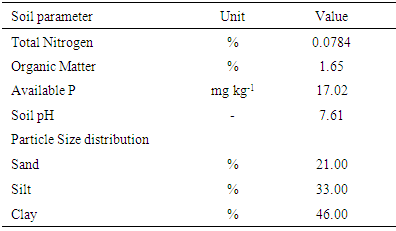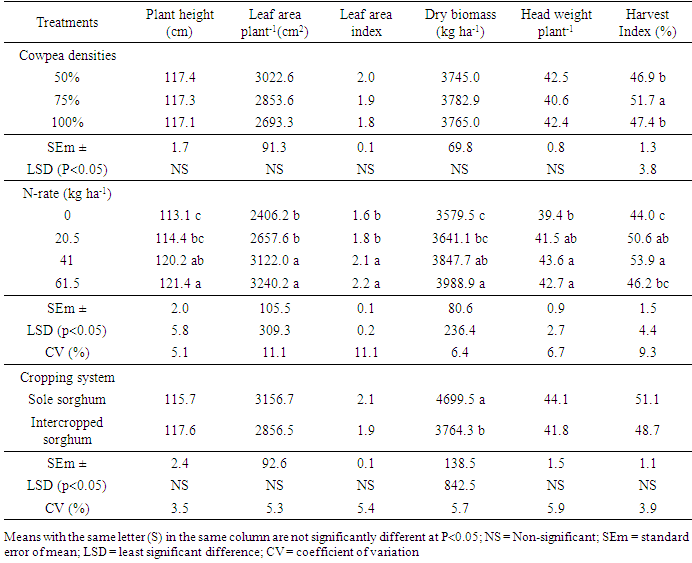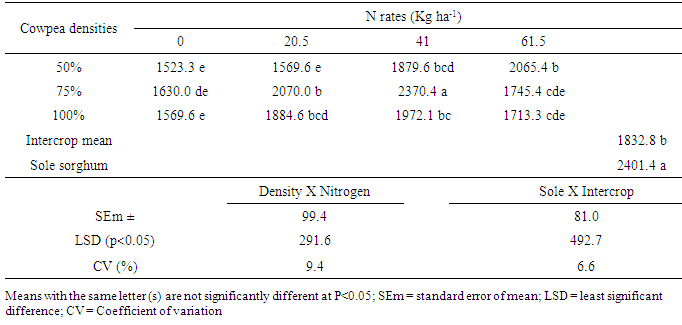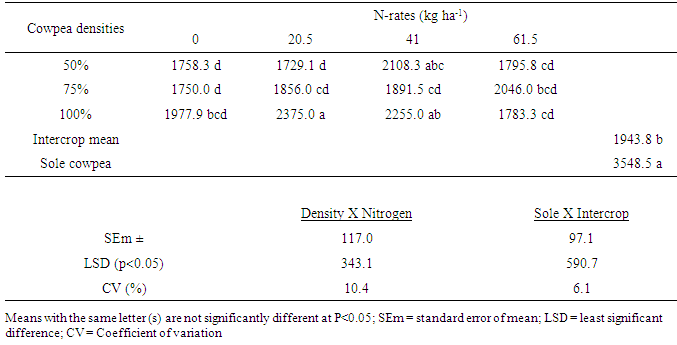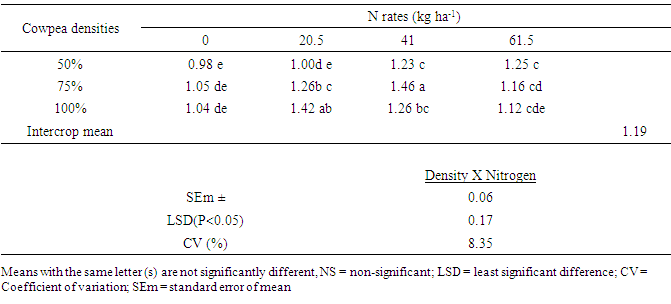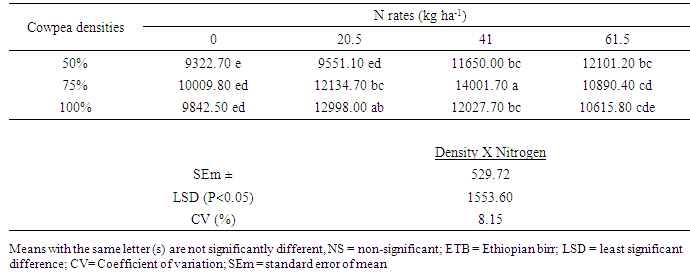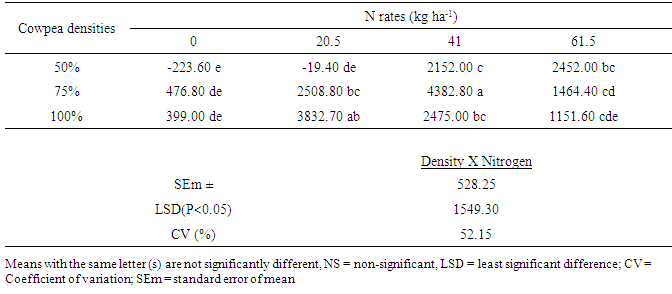-
Paper Information
- Previous Paper
- Paper Submission
-
Journal Information
- About This Journal
- Editorial Board
- Current Issue
- Archive
- Author Guidelines
- Contact Us
International Journal of Agriculture and Forestry
p-ISSN: 2165-882X e-ISSN: 2165-8846
2015; 5(6): 305-317
doi:10.5923/j.ijaf.20150506.02

Effect of Cowpea Density and Nitrogen Fertilizer on a Sorghum-Cowpea Intercropping System in Kobo, Northern Ethiopia
Berhane Sibhatu1, Ketema Belete2, Taye Tessema3
1Ethiopian Institute of Agricultural Research, Mehoni Research Center, Maichew, Ethiopia
2Department of Plant Sciences, Haramaya University, Haramaya, Ethiopia
3Integrated Striga Control Project (ISC), Adis Ababa, Ethiopia
Correspondence to: Berhane Sibhatu, Ethiopian Institute of Agricultural Research, Mehoni Research Center, Maichew, Ethiopia.
| Email: |  |
Copyright © 2015 Scientific & Academic Publishing. All Rights Reserved.
This work is licensed under the Creative Commons Attribution International License (CC BY).
http://creativecommons.org/licenses/by/4.0/

Sorghum productivity is limited in Kobo area mainly due to deterioration of soil fertility and continuous cropping. Hence, an experiment on sorghum/cowpea intercropping was conducted in 2014/15 cropping season to assess the effect of density of the intercropped cowpea and nitrogen fertilizer rates on yield and yield related traits of sorghum and cowpea as well as to determine the appropriate plant density of cowpea and nitrogen fertilizer rate that maximize the productivity of the intercrop system. Treatments consisted of factorial combinations of three cowpea densities (50, 75 and 100%) and four levels of nitrogen rates (0, 20.5, 41 and 61.5kg N ha-1) accompanied with sole sorghum and sole cowpea, carried out in Randomized Complete Block Design (RCBD) with three replications. The analyzed result showed that plant height and dry biomass yield of sorghum as well as leaf area and leaf area index of both crops showed an increased trend as N level increased linearly. Leaf area index of cowpea was also affected by cowpea density in which the largest data was recorded at high population density. Similarly, grain yields of component crops were significantly influenced (P<0.01) due to the interaction effect. Thus, the highest grain yield of sorghum (2370.4 kg ha-1) and cowpea (821.3 kg ha-1) were obtained from the combination of 41 kg N ha-1 + 75% sole cowpea density, and 20.5 kg N ha-1 + 100% of cowpea density, respectively. Similarly, 20.5 kg N ha-1 + 100% planting density produced the highest dry biomass (2375.0 kg ha-1) of cowpea. The land equivalent ratio (LER) and gross monetary value (GMV) showed that sorghum-cowpea intercropping was highly superior to and more advantageous over sole cropping. The highest values of LER and GMV were obtained from combination of 41 kg N ha-1 and 75% sole cowpea density. This is, therefore, sorghum-cowpea intercropping was proved to be more productive and efficient system in utilizing land compared to sole cropping with carefully managed N fertilizer and cowpea plant density. Hence, combination of 41 kg N ha-1 and 75% sole cowpea density can be recommended for the farmers in the study area to improve sorghum productivity and the cropping system at large.
Keywords: Cowpea, Economic analysis, Intercropping, Nitrogen, Plant population, Sorghum
Cite this paper: Berhane Sibhatu, Ketema Belete, Taye Tessema, Effect of Cowpea Density and Nitrogen Fertilizer on a Sorghum-Cowpea Intercropping System in Kobo, Northern Ethiopia, International Journal of Agriculture and Forestry, Vol. 5 No. 6, 2015, pp. 305-317. doi: 10.5923/j.ijaf.20150506.02.
Article Outline
1. Introduction
- Sorghum [Sorghum bicolor (L) Moench] is among the dominant staple cereals for the majority of Ethiopians. In Ethiopia, it is adapted to a wide range of environments, and hence can be produced in the high lands, medium altitude and low lands. Sorghum is widely produced more than any other crops in the areas where there is moisture stress (MoA, 2010). According to the study of MoA (2010), the grain is used for human food like porridge, “injera”, “Kitta”, “Nifro”, infant food, syrup, and local beverages such as “Tella”, and “Areke”. Besides to animal feed, the stalk is used for construction of houses and fence, and as fuel wood.In Ethiopia, during 2013/14, sorghum encompasses about 13.5% of the total of 79.4% area allotted to cereal crop production (tef, maize, sorghum, and wheat). Similarly, during the same year, sorghum took 15.2% (3,828,870,103 kg) of the total production (21,583,522,561 kg) allocated for major cereals (maize, tef, wheat, and sorghum). In that year, sorghum was the most important staple food crop ranked 3rd and 4th in area coverage and total production, respectively (CSA, 2014). In the country, sorghum is grown in almost all regions occupying an estimated total land area of 1.68 million ha and its national average productivity is 2283 kg/ha (CSA, 2014). However, the productivity of sorghum is limited due to deterioration in soil fertility, shortening of the length of fallow, and the increasing trend towards continuous cultivation of cereal monocrops in place of traditional rotation and intercropping systems, and lack of agricultural inputs (UNDP, 1996).Cereal-legume intercropping is among the approaches that induces productivity of crops. According to the reports across Africa on soybean-sorghum (Hayder et al., 2003), cowpea-maize (Eskandari and Ghanbari, 2010), sorghum-legume (Aliyu and Emechebe, 2006) and maize-legumes (Seran and Brintha, 2010; Tilahun et al., 2012) intercropping systems have a higher productivity than the sole cereal systems in semi-arid areas. The reason of yield advantage of intercropping are mainly that environmental resources such as water, light and nutrients can be utilized more efficiently in intercropping than in the respective sole cropping systems (Liu et al., 2006). By using the land equivalent ratio (LER) one is able to compare the production of the intercrop and express it relative to the yield from a sole crop of the dominant species (Beets, 1982). Farmers in different parts of the world intercrop different crops according to their preference based on social and biological needs (Andrew and Kassam, 1983). For example, sorghum - cowpea intercropping is an important farming system for small scale farmers in Arid and Semi-Arid Lands of sub-Sahara African (Karanja et al., 2014). In Ethiopia, cowpea [Vignaun guiculata (L) Walp] is now becoming among the most commonly cultivated lowland pulse crops. It is grown in rift valley areas of Ethiopia for its fodder and grain value (dual purpose) (Ayana et al., 2013). Intercropping with cowpea leads to higher sorghum grain yield which may be related to the benefits of N fixation under cowpea intercropping as well as to induction of suicidal germination of Striga seeds away from the host roots. For the success of intercropping system several aspects need to be taken into consideration before and during the cultivation process (Seran and Brintha, 2010). Such considerations include maturity of crop, compatible crops, time of planting and plant density. Report of Francis (1989) revealed that the potential of cereal-legume intercropping system to provide N depends on density of crops, light interception, crop species and nutrients. Accordingly, Adem (2006) reported that leaf area plant-1, leaf area index, and dry biomass yield plant-1 of sorghum were significantly affected due to nitrogen application under sorghum-cowpea intercropping. In the same report, leaf area index was significantly affected due to component planting density. The seedling rate of each crop in intercrop is adjusted below its full rate to optimize plant density. According to Seran and Brintha (2010), by planting full rate of each crop neither would yield well because of intense overcrowding. Morgado and Willey (2003) also reported that dry matter yield accumulation of individual maize plant decreased with increase in bean plant population. Furthermore, studies in Ethiopia indicated that wheat and faba bean were grown in an additive intercropping system which increased the LER by between 3 and 22%. The highest total grain yield was obtained when a full wheat crop was intercropped with a 37.5% faba bean crop (Agegnehu et al., 2008). It is evident from various workers that intercropping gives higher yield when total population in the system is higher than that of sole crops (Willey, 1979b). Legumes with effective biological nitrogen fixation (BNF) can be grown with less applied N fertilizer. Appropriate fertilization with respect to type, amount, time, and method of fertilizer application can increase the advantage of intercropping (Undie et al., 2012). Due to the rising cost of chemical fertilizers, crop nutrient uptake and utilization must be most efficient to reduce cost of production and achieving higher profit. Hence, intercropping legumes with cereals is particularly important in countries where the cost of N fertilizer is high and / or availability of fertilizer is limited. Rebka et al. (2013) reported that unaffordable high costs, the low fertilizer response of landraces and the extreme drought at the end of growing seasons limit the use of inorganic fertilizer by famers in north Wollo. Legumes with effective biological nitrogen fixation (BNF) can be intercropped with cereals with less applied N fertilizer to overcome this problem. Hence, assessing the performance of intercropping cowpea at different population densities with application of N to enhance the overall productivity of the component crops is very important. Accordingly, this study was aimed to assess the effect of density of the intercropped cowpea and nitrogen fertilizer rates on yield and yield related traits of sorghum and cowpea; and also to determine the appropriate plant density of cowpea and nitrogen fertilizer rate that maximize the productivity of the intercrop system.
2. Materials and Methods
2.1. Description of Experimental Area
- The experiment was carried out under rain-fed conditions in Kobo Agricultural Research sub-Center testing site in the 2014/15 cropping season. It is 570 km north of Addis Ababa and situated at an altitude of 1470 meters above sea level (m.a.s.l) having a long term average rainfall of 459 mm and its average annual temperature is 15 – 31°C. It lies at latitudes of 12°09’ N and longitudes of 39°38’ E. It has eutricvertisol and eutricfluvisol soil types (Wondimu et al., 2005). The area is characterized by bimodal rainfall pattern with a short rainy season (belg) from February to April and a long rainy season (kirmet) from June to September with a peak in August (Tsegaye Gebremariam, personal communication, April 23, 2014).
2.2. Treatments and Filed Experimental Design
- Factorial combinations of four rates of nitrogen (0, 20.5, 41, and 61.5 kg N/ha), three rates of cowpea planting densities (50%, 75% and 100%) including sole cowpea and sorghum under sorghum-cowpea intercropping were laid out in a randomized complete block design (RCBD) with three replications in a plot area of (3.75 * 4) m2. Urea (46%N) was used as source of N. The recommended amount of N fertilizer (41 kg N ha-1) was applied for sole sorghum. Half dose of the N rates was applied during planting time and the remaining was applied at knee stage. Similarly, full dose of P (46 kg P2O5 ha-1) was applied as band application in the form of triple super phosphate (TSP) at planting time for both sorghum and cowpea rows in all treatments while N was applied for sorghum rows only. Bekur variety of cowpea and P-9401 (Gubiye) variety of sorghum were used as test crops. Sorghum was planted at a spacing of 75 x 20 cm while cowpea, which had been planted three weeks later after sorghum at 1:1 sorghum-cowpea spatial arrangement, was planted with intra-row spacing of 13 cm, 17 cm and 25 cm based on the treatments which represented 100%, 75% and 50% of the recommended cowpea planting density, respectively. Moreover, sole cowpea was planted at a spacing of 60 x 20 cm. In-situ soil moisture conservation practice (tied ridging) was done for all plots to harvest water.
2.3. Data Collection
- Soil sample at a depth of 0-30 cm was taken from five random spots diagonally across the experimental field using auger before planting. The collected soil samples were composited to one sample. The bulked soil samples were air dried, thoroughly mixed and ground to pass 2 mm sieve size before laboratory analysis.Five random plants plot-1 from the net plot (2.25 m * 3.6 m) were taken to measure leaf area plant-1 (cm2) of sorghum. Physiologically well performed three leaves plant-1 were considered. It was determined at 50% heading using the method described by Sticker et al. (1961) as: Leaf area = leaf length of the leaves x maximum width of leaf x 0.75. Where, 0.75 is the correction factor for sorghum. Similarly, Leaf area plant-1 (cm2) of cowpea was determined by stacking the leaf laminae of the five sample plants on the table at 50% flowering stage and a cork borer of known area was driven through them to cut out discs. Ten physiological well performed leaves plant-1 were sampled. The complete disc where counted and weighed both when fresh and after drying completely. The remaining parts after cutting of discs where combined as per the discs. The weights obtained were used to determine the leaf area as described by Ibrahim et al. (2014):
 Where:A = Total leaf area plant-1 (cm2); a = area of individual discs (cm2); n = number of discs taken; w = weight of dry n discs (gm) and W = Total dry weight of leaves plant-1 (gm). Five random plants plot-1 from the net plot (2.25 m * 3.6 m) were taken to measure Leaf Area Index (LAI) of the component crops. It was calculated as the ratio of unit leaf area per unit ground from the net plot according to Watson (1958) where unit leaf area = leaf area x No. of leaves/plants. Plant height (cm) of the crops was measured from five randomly taken plants of each net plot at 90% physiological maturity with a standard meter rule. Five sampled panicles of sorghum from the net plot were bulked and mixed together at 12.5% moisture level to determine head weight plant-1 (gm). Effective nodules number plant-1 of cowpea were collected at the time of 50% flower initiation by digging out the roots of five plants randomly from the net plot and were counted based on their colour (pink colour). Number of pods plant-1 was determined from the five sampled plants of a net plot at physiological maturity. Number of seed pod-1 of cowpea was also determined from 15 pods taken from the five sampled plants. Similarly, grain yield (kg ha-1) of both crops was determined after the grain had been dried, threshed, cleaned and adjusted to 12.5% moisture level (sorghum) and 10.5% moisture level (cowpea). The above ground biomass (kg ha-1) of the test crops was measured after the plants from the net plot area had been harvested and sun dried till constant dry weight was attained. Harvest index of the crops was also computed as ratio of grain dry weight to above ground dry biomass expressed in percentage.Land equivalent ratio (LER) was used to evaluate the productivity of intercrops compared with mono-crops. It was calculated according to Mead and Willey (1980):
Where:A = Total leaf area plant-1 (cm2); a = area of individual discs (cm2); n = number of discs taken; w = weight of dry n discs (gm) and W = Total dry weight of leaves plant-1 (gm). Five random plants plot-1 from the net plot (2.25 m * 3.6 m) were taken to measure Leaf Area Index (LAI) of the component crops. It was calculated as the ratio of unit leaf area per unit ground from the net plot according to Watson (1958) where unit leaf area = leaf area x No. of leaves/plants. Plant height (cm) of the crops was measured from five randomly taken plants of each net plot at 90% physiological maturity with a standard meter rule. Five sampled panicles of sorghum from the net plot were bulked and mixed together at 12.5% moisture level to determine head weight plant-1 (gm). Effective nodules number plant-1 of cowpea were collected at the time of 50% flower initiation by digging out the roots of five plants randomly from the net plot and were counted based on their colour (pink colour). Number of pods plant-1 was determined from the five sampled plants of a net plot at physiological maturity. Number of seed pod-1 of cowpea was also determined from 15 pods taken from the five sampled plants. Similarly, grain yield (kg ha-1) of both crops was determined after the grain had been dried, threshed, cleaned and adjusted to 12.5% moisture level (sorghum) and 10.5% moisture level (cowpea). The above ground biomass (kg ha-1) of the test crops was measured after the plants from the net plot area had been harvested and sun dried till constant dry weight was attained. Harvest index of the crops was also computed as ratio of grain dry weight to above ground dry biomass expressed in percentage.Land equivalent ratio (LER) was used to evaluate the productivity of intercrops compared with mono-crops. It was calculated according to Mead and Willey (1980): Where;Yab = yield per unit area of crop a in mixture; Yaa = yield per unit area of pure crop a; Yba = yield per unit area of crop b in mixture; Ybb = yield per unit area of pure crop b.Gross monetary value (GMV) and monetary advantage (MA) were calculated from the yield of sorghum and cowpea in order to measure the productivity and profitability of intercropping as compared to sole cropping of the associated component crops (Mead and Willey, 1979). GMV was calculated by multiplying yields of the component crops by their respective current market price. According to Willey (1979a), MA was calculated as:
Where;Yab = yield per unit area of crop a in mixture; Yaa = yield per unit area of pure crop a; Yba = yield per unit area of crop b in mixture; Ybb = yield per unit area of pure crop b.Gross monetary value (GMV) and monetary advantage (MA) were calculated from the yield of sorghum and cowpea in order to measure the productivity and profitability of intercropping as compared to sole cropping of the associated component crops (Mead and Willey, 1979). GMV was calculated by multiplying yields of the component crops by their respective current market price. According to Willey (1979a), MA was calculated as: 
2.4. Data Analysis
- The collected data were subjected to the analysis of variance (ANOVA) using the SAS computer package version 9.1 (SAS Institute, 2004). Mean separation was carried out using least significance difference (LSD) test at 5% probability level as described in Gomez and Gomez (1984).
3. Results and Discussion
3.1. Soil Analysis
- Analysis of soil samples before planting was done for the major soil physical and chemical properties at soil laboratory of Mekelle Soil Research Center (Table 1). The results in Table 1 indicated that the soil comprised total N of 0.0784%, characterizing a low level of N (Berhanu, 1980). It also showed that the available P content was rated under high (17.02 mg kg-1, Olsen et al., 1954). The organic matter content of the soil was 1.62%, which rated under low, in agreement with findings of Tekalign (1991).Moreover, the pH value was 7.61. According to Tekalign (1991), soils having pH value in the range of 7.4 to 8.0 are considered moderately alkaline soils. The soil of the experimental site had a proportion of 21% sand, 33% silt, and 46% clay that can be texturally classified as clay soil (Table 1).
|
3.2. Sorghum Component
- Plant height of intercropped sorghum was affected significantly (P< 0.05) due to the effect of N (Table 2). The tallest plant height (121.4 cm) was recorded with the application of 61.5 kg ha-1 and was statistically similar (P< 0.05) to the plant height (120.2 cm) obtained due to application of 41 kg ha-1. The lowest plant height (113.1cm) was recorded from unfertilized plots. Use of 61.5 kg ha-1gave 7.31% more advance in plant height than nil fertilizer. This increment could be due to the vital role of N in enlargement of vegetative growth of plant parts. This result correlates with Abebe et al. (2013), who reported that there was significant variation in plant height of intercropped maize due to integrated N fertilizer application on maize-soybean intercropping.Leaf area of sorghum was highly significantly affected (P<0.01) by N fertilizer application but no significant effect of cowpea plant density, interaction effect nor cropping system. The highest leaf area was obtained with the application of 61.5 and 41 kg N ha-1 as compared to 20.5 and 0 kg N ha-1 (Table 2). Leaf area showed an increased trend as level of N increased. Those results insured the importance of N in stimulating and enhancing the photosynthetic and metabolic activities of plants, which reflected on the increase in the vegetative growth of sorghum. A report from Wondimu et al. (2005) suggested that the higher leaf, stem and panicle dry mass of sorghum with N fertilization could be due to the positive effect of N on canopy development as a result of alterations in leaf area development. Ayoola and Agboola (2002) similarly reported that application of inorganic fertilizers and farm yard manure increased growth and expansion of leaves in intercropped maize.
|
3.3. Cowpea Component
- Neither of the main effects (cowpea density and nitrogen) nor their interactions and cropping system caused a significant influence on plant height of intercropped cowpea (Table 4). This might be attributed to less shading effect of sorghum and competition on the intercropped cowpea. This result confirms the finding of Ibrahim et al. (2014), who reported that plant height of cowpea did not give significant response (P<0.05) to sorghum-cowpea intercropping. Likewise, Abraha (2013) reported that the height between lablab-maize and sole lablab was not statistically affected.
|
|
|
3.4. Total Land Productivity and Gross Return Evaluation
- The productivity of this experiment was evaluated by land equivalent ratio (LER) and gross monetary value (GMV) as indices. Thus, the analyzed data in Table 7 depicted that land equivalent ratio (LER) was highly significantly affected (P<0.01) by main effects, interaction of main effects and cropping system. The highest LER (1.46) had been achieved when 41 kg N ha-1 was applied to 75% sole cowpea density. Statistically, it was at par with the interaction of 20.5 kg N ha-1 and 100% cowpea density. Nevertheless, the lowest LER (0.98) was recorded on plots having 50% of sole cowpea density with no N fertilizer (Table 7). Concerning to the result in Table 7, in all interactions the LER was more than unity except in the treatment that received 50% of sole cowpea density with no N fertilizer application validating that limited soil fertility significantly reduces the productivity of intercropping system. LER more than unity implied that intercropping of sorghum and cowpea is advantageous in many instances rather than sole planting.
|
|
|
4. Conclusions
- This experiment was conducted to assess the effect of plant densities of the intercropped cowpea and N fertilizer rates on yield and yield related traits of sorghum and cowpea as well as to determine the appropriate plant density of cowpea and nitrogen fertilizer rate that maximize the productivity of the intercrop system. Hence, it was found that N significantly affected plant height, leaf area, leaf area index and dry biomass of sorghum. Increasing of N rate enhanced performance of those parameters. Accordingly, the highest of each was registered due to 61.5 kg N ha-1. Needless to say, grain yield was affected by the main effects, their interaction and cropping system. The highest grain yield (2370.4 kg ha-1) was obtained from the combination of 41 kg N ha-1 and 75% sole cowpea density. Similarly, leaf area and leaf area index (LAI) of cowpea showed statistically significant response to N. They showed an increased trend at high level of N. LAI was also significantly affected due to cowpea density where the highest LAI was obtained at 100% cowpea density. The main effects as well as their interaction and cropping system considerably affected the grain yield. As a result, the highest grain yield (821.3 kg ha-1) was obtained when 20.5 Kg N ha-1 interacts with 100% of cowpea density. As explained in grain yield, similar situation also occurred in dry biomass yield of cowpea. The LER and GMV analysis showed that sorghum-cowpea intercropping was highly superior to and more advantageous over sole cropping. The highest LER (1.46) and GMV (14001.70 ETB ha-1) were achieved at combination of 41 kg N ha-1 and 75% sole cowpea density while the lowest LER (0.98) and GMV (9322.70 ETB ha-1) were recorded on plots having 50% of sole cowpea density without N fertilizer. In general, the system is more reliable for sustainable and environmentally safe cereal crop production due to the N fixation nature of cowpea and its compatible nature. This is, therefore, sorghum-cowpea intercropping was proved to be more productive and efficient system in utilizing land compared to sole cropping with carefully managed N fertilizer and cowpea plant density. Hence, combination of 41 kg N ha-1 and 75% sole cowpea density can be recommended for the farmers in the study area to improve sorghum productivity.
ACKNOWLEDGEMENTS
- The authors are grateful to Integrated Striga Control Project, under the Ethiopian Institute of Agricultural Research (EIAR), for funding this research project. We also sincerely acknowledge the Mehoni Agricultural Research Center and Kobo Agricultural Research sub-Center for providing all farm facilities. Appreciation is due for the services of the analytical soil laboratory of Mekelle Soil Research Center.
References
| [1] | Abebe Zerihun, Sharma, J.J., Dechasa Nigussie and Fred, K. 2013. The effect of integrated organic and inorganic fertilizer rates on performances of soybean and maize component crops of a soybean/maize mixture at Bako, Western Ethiopia. African Journal of Agricultural Research, 8(29: 3921-3929. |
| [2] | Abraha Lemlem. 2013. The effect of intercropping maize with cowpea and lablab on crop yield. Herald Journal of Agriculture and Food Science Research, 2 (5):156 – 170. |
| [3] | Adem Mohammed, 2006. Effects of component density of Striga resistant sorghum and cowpea, and N rates on productivity of intercropping system in North Wollo, Ethiopia. MSc. Thesis, Haramaya University, Haramaya, Ethiopia. |
| [4] | Agegnehu G., Ghizaw A. and Sinebo W. 2008. Yield potential and land-use efficiency of wheat and faba bean mixed intercropping. Agron Sustain Dev 28:257-263. |
| [5] | Ajeigbe, H.A., Singh, B.B and Oseni, T.O. 2005. Cowpea-cereal intercrop productivity in the Sudan Savana Zone of Nigeria as affected by planting pattern, crop variety and pest management. African Crop Science Journal, 13(4): 269-279. |
| [6] | Aliyu, B.S. and Emechebe, A.M. 2006. Effect of Intra- and inter-row mixing of sorghum with two varieties of cowpea on host crop yield in a Striga hermonthica infested field. African Journal of Agricultural Research, 1 (2): 24-26. |
| [7] | Andrew, D.J and A.H. Kassam. 1983. The importance of multiple cropping in increasing world food supply. In: Papendic, R.I. (ed.) Multiple Cropping. American Society of Agronomy, 677 South Segoe Road Madison, Wisconsin 53711. PP. 7-32. |
| [8] | Ayana Etana, Estefanos Tadesse, Ashenafi, Mengstu, Abubeker Hassen. 2013. Advanced evaluation of cowpea (Vigna unguiculata) accessions for fodder production in the central rift valley of Ethiopia. Journal of Agricultural Extension and Rural Development, 5(3): 55-61. |
| [9] | Ayoola, O.T. and Agboola, A.A., 2002. Influence of cassava planting pattern and organic-inorganic fertilizer sources on the growth and yield of maize in cassava – maize- melon intercrop in South west Nigeria. Journal of Agricultural Res., 3(2): 161-168. |
| [10] | Beets, W.C. 1982. Multiple Cropping and Tropical Farming Systems. Westview Press, Boulders. |
| [11] | Berhanu Debele. 1980. The physical criteria and their rating proposed for land evaluation in the highland region of Ethiopia. Land Use Planning and Regulatory Department, Ministry of Agriculture, Addis Ababa, Ethiopia. |
| [12] | Biruk Tesfaye. 2007. Effects 0f Planting Density and Varieties of Common Bean (Phaseolus vulgaris L.) Intercropped with Sorghum (Sorghum bicolor L.) on Performance of the Component Crops and Productivity of the System in South Gondar, Ethiopia. MSc. Thesis, Haramaya University, Haramaya, Ethiopia. |
| [13] | Cenpukdee, U and S. Fukai. 1991. Effect of nitrogen supply on Cassava / pigeon pea intercropping with three contrasting Cassava cultivars. Fert.Res. 29: 275-280. |
| [14] | Chemeda Fininsa. 2003. Relationship between bacterial blight severity and bean yield loss in pure stand and bean-maize intercropping systems. International Journal of pest management, 49(3): 177-185. |
| [15] | CSA (Central Statistics Agency). 2014. Report on Area and Production of Major Crops (Private Peasant Holdings, Meher Season): Agricultural Sample Survey. Central Statistics Agency, Addis Ababa, Ethiopia. |
| [16] | Egbe, O.M. 2010. Effects of plant density of intercropped soybean with tall sorghum on competitive ability of soybean and economic yield at Otobi, Benue State, Nigeria. Journal of Cereals and Oilseeds, 1(1):1 – 10. |
| [17] | Eskandari, H., A. Ghanbari. 2010. Environmental resource consumption in wheat and bean intercropping: Comparison of nutrient uptake and light interception. Notulae Scientia Biologicae, 2(3):100-103. |
| [18] | Fisher, N.M, Layoock, D., Masyansa, B.S.K. and Owuor, J.O. 1986. Report on mixed cropping experiments in the West of Kenya during the 1975 season. Field Beans, 11(43): 367-370. |
| [19] | Francis, C.A., 1989. Biological efficiency in multiple cropping systems. Adv. Agro., 42:1-42. |
| [20] | Getachew Bekele, Ketema Belete and Sharma, J.J. 2013. System Productivity of Forage Legumes Intercropped with Maize and Performance of the Component Crops in Kombolcha, Eastern Ethiopia. East African Journal of Sciences, 7 (2): 99-108. |
| [21] | Gomez, K.A. and A. A. Gomez. 1984. Statistical procedures for agricultural research (2nd ed.). John Viley and Sons Inc., New York. |
| [22] | Hayder Ghulam, S., Suhail Mumtaz, Aslam Khan, Sherin Khan. 2003. Maize and Soybean Intercropping under Various Levels of Soybean Seed Rates. Asian Journal of Plant Science, 2(3): 339-341. |
| [23] | Herridge, D.F. 1982. Use of the ureide technique to describe the nitrogen economy of fieldgrown Soybeans. Plant Physiology, 70: 7-11. |
| [24] | Ibrahim, H.A, Singh, L., and Babaji, G.A. 2014. Evaluating yield performance of cowpea varieties under sole and intercropping with sorghum at Bauchi Nigeria. Ethiopian Journal of Environmental Studies and Management 7 Suppl. Pp.709-719. doi: http://dx.doi.org/10.4314/ejesm.v7i1.2S |
| [25] | Jat. P.C., Rathore. S.S., Sharma. R.K. 2014. Effect of Integrated Nitrogen Management and Intercropping Systems on Yield Attributes and Yield of Maize. Indian Journal of Hill Farming, 27(1):52-56 |
| [26] | Karanja, S.M., Kibe, A.M., Karogo, P.N. and Mwangi, M. 2014. Effects of Intercrop Population Density and Row Orientation on Growth and Yields of Sorghum - Cowpea Cropping Systems in Semi-Arid. Rongai, Kenya, Journal of Agricultural Science; Vol. 6, No. 5. |
| [27] | Karikari, S.K.., O. Choba and B. Molosiwa. 1999. Effect of intercropping bambara groundnut on pear millet, sorghum and maize in Botswana. African Crop Science Journal, 7(2): 143-152. |
| [28] | Khola, O.P.S. and D. P. Singh. 1996. Comparative Performance of Swedge rape (Brassica napus) and Ethiopian mustard (Brassica carinata) in intercropping with French bean (Phaseolus vulgaries). Indian Journal of Soil Conservation. 24 (1): 68-73. |
| [29] | Lithourgidis, A.S., Dordas, C.A., Damalas, C.A. and Vlachostergios, D.N. 2011. Annual intercrops : an alternative path way for sustainable agriculture. Review article, Australian Journal of Crop Science, AJCS 5(4): 396-410. |
| [30] | Liu, J.H., Z.H. Zeng, L.X. Jiao, Y.G. Hu, Y. Wang, H. Li. 2006. Intercropping of different silage maize cultivars and alfalfa. Acta. Agron. Sci. 32:125- 130. |
| [31] | Lucius, L. and Van Slayke. 2010. Fertilizers and crop production. Agriobioss press, New Delhi, India. |
| [32] | Mahmoud. E.A., Ramadan. B.S.H., Bekheet. M.A. and Gomaa. M.A., 2013. Effect of Nitrogen Fertilization and Plant Density on Productivity and Quality of Sweet Sorghum. American-Eurasian Journal of Agriculture & Environmental Science, 13 (5): 654-659. DOI:10.5829/idosi.aejaes.2013.13.05.1990. |
| [33] | Mead, R. and Willey, R.W. 1980. The concept of a ‘land equivalent ratio’ and advantages in yields from intercropping. Experimental Agriculture, 16:217-228. |
| [34] | Minale Liben, Tilahun Tadesse and Alemayehu Assefa. 2001. Determination of nitrogen and phosphorus fertilizer levels in different maize-faba bean intercropping pattern in North Western Ethiopia. Pp. 513-518. Seventh Estern and Southern Africa Regional Maize Conference 11th-12th February, 2001. |
| [35] | MoA (Ministry of Agriculture). 2010. Animal and Plant Health Regulatory Directorate. Crop variety register issue no.13.Addis Ababa, Ethiopia: HY international printing enterprise. |
| [36] | Morgado, L.B. and Willey, R.W. 2003. Effects of plant population and nitrogen fertilizer on yield and efficiency of maize-bean intercropping. Pesq. agropec. bras., Brasília, 38(11):1257-1264. |
| [37] | Muchow, R.C. 1988. Effect of nitrogen supply on the comparative productivity of maize and sorghum in a semi-arid tropical environment. I. Leaf growth and leaf nitrogen. Field Crops Research, 18: 1-16. |
| [38] | Noel, K.O., M. Carneol and W.J. Brill. 1982. Nodule Protein Synthesis and Nitrogenase Activity of Soy Bean Exposed to Fixed Nitrogen. Plant Physiology, 70: 1236-1241. |
| [39] | Olsen, S.R., Cole, V.,Walanbe, C.V. and L.A. Dean. 1954. Estimation of Available phosphorus in soils by extraction with Sodium Bicarbonate. USA Circular NO 939. |
| [40] | Omae, H., Saidou, A.K. and Tobita, S. 2014. Improving Millet-Cowpea Productivity and Soil Fertility with Crop Rotation, Row Arrangement and Cowpea Density in the Sahel, West Africa. American-Eurasian journal of Agriculture & Environmental Science, 14 (2): 110-115, 2014. |
| [41] | Rebeka Gebretsadik, H. Shimelis, M.D. Laing, P. Tongoona, N. Mandefro. 2013. A diagnostic appraisal of the sorghum farming system and breeding priorities in Striga infested agro-ecologies of Ethiopia. Agricultural System, http://dx.doi.org/10.1016/j.agsy.2013.08.008. Accessed on January 12, 2015. |
| [42] | Saleem, R, Z. I. Ahmad, M. A. Anees, A. Razzaq and A. Saleem. 2015. Productivity and land use efficiency of maize-mungbean intercropping under different fertility treatments. Sarhad Journal of Agriculture, 31(1): 37-44. |
| [43] | SAS Institute. 2002. SAS/STAT user’s guide, version 9.0, SAS Inst., Cary, NC. |
| [44] | Seran, H.T. and Brintha, I. 2010. Review on maize Based Intercropping. Asian Network for Scientific Information, Journal of Agronomy, Pp.1-3. |
| [45] | Siddig. A., Mohamed, Ali, Adam. A. Mohamed, Ali. H. Bahar and Abdulmohsin. R. Khairelseed. 2013. Effects of Sorghum (Sorghum bicolor L.) Moench) and Groundnut (Arachis hypogaea L.) İntercropping on some soil chemical properties and crop yield under rain-fed conditions. ARPN Journal of Science and Technology, 3:1. |
| [46] | Solomon, G. and Kibrom, G. 2014. Forage production potential and nutritive value of cowpea (Vigna unguiculata) genotypes in the northern lowlands of Ethiopia. E3 Journal of Agricultural Research and Development, 5(4):066-071. |
| [47] | Sticker, F.C, S. Wearden and A.W. Pauli. 1961. Leaf Area Determination in Grain Sorghum. Agronomy Journal, 53: 187-188. |
| [48] | Tamado Tana and Eshetu Mulatu. 2000. Evaluation of Sorghum, Maize and Common Bean Cropping System in East Hararghe, Eastern Ethiopia. Ethiopian Journal of Agricultural Science, 17: 33-45. |
| [49] | Tauro. T.P, J. Adu-Gyamfi, Dhliwayo, D.K..C and Heng, L.K. 2013. Nitrogen and phosphorus budgets for sorghum and cowpea production under simulated sole- and intercropping systems in low- and medium-P soils. African Journal of Agricultural Research. Vol. 8(9): 727-735, DOI: 10.5897/AJAR11.494. Accessed on Decembre 10, 2014. Research, 8(9): 727-735. |
| [50] | Tekalign Tadese. 1991. Soil, plant, water, fertilizer, animal manure and compost analysis. Working Document No. 13. International Livestock Research Center for Africa, Addis Ababa, Ethiopia. |
| [51] | Tilahun Tadesse, Minale Liben and Alemayehu Asefa. 2012. Role of maize (Zea mays L.)- fababean (Vicia faba L.) intercropping planting pattern on productivity and nitrogen use efficiency of maize in northwestern Ethiopia highlands. International Research Journals, 2(3):102-112. |
| [52] | Tisdale, S.L., Nelson, W.L., Beaton, J.D. and Havlin, J.L. 1995. Soil Fertility and Fertilizers, 5th edition, Macmillan, New York, USA. |
| [53] | Undie, U.L., D. F. Uwah and E. E. Attoe. 2012. Effect of Intercropping and Crop Arrangement on Yield and Productivity of Late Season Maize/soybean Mixtures in the Humid Environment of South Southern Nigeria. Journal of Agricultural Science. 4(4): 1-16. |
| [54] | UNDP, 1996. Sustainable Agriculture and Environmental Rehabilitation Program (SAERP). Stastical Master Book on Sectoral Conditions and Activities in the Amhara Regional State. Volume II. Joint production of the Amhara Regional Council and Economic Commission for Africa. UNDP/ECA. SAERP /WARDIS Project, northern Ethiopia. PP. 35-45. |
| [55] | Watson, D.J. 1958. The dependence of net assimilation rate on leaf area index. Ann. Bot. Land, N.S. 22: 37-54. |
| [56] | Willey, R.W. 1979a. Intercropping, its importance and research Needs. I. Competition and Yield Advantages. Field Crop Abstract, 32: 1-10. |
| [57] | Willey, R.W. 1979b. Intercropping, its importance and research Needs. II. Agronomy and research approach. Field Crop Abstract, 32: 78-85. |
| [58] | Willey, R.W. 1985. Evaluation and presentation of intercropping advantages. Experimental Agriculture, 21:119-133. |
| [59] | Wondimu Bayu, N. F.G. Rethman and P. S. Hammes. 2005. Growth and yield compensation in sorghum (Sorghum bicolor L. Moench) as a function of planting density and nitrogen fertilizer in semi-arid areas of northeastern Ethiopia. South African Journal of Plant and Soil, 22(2):76-83. |
 Abstract
Abstract Reference
Reference Full-Text PDF
Full-Text PDF Full-text HTML
Full-text HTML